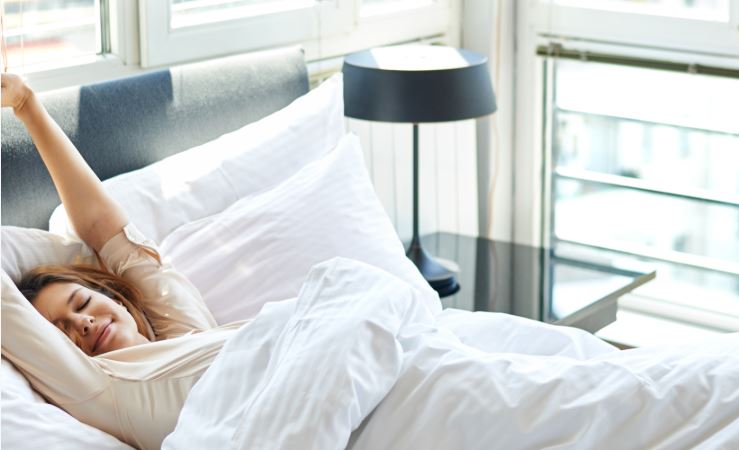Demand better sleep

March 14th 2019
Sleep Awareness Week is here. Everyone sleeps, so of course we’re all aware of sleep to some degree. We feel better when we get the recommended 7-8 hours of sleep per night: we’re more alert, more engaged, often happier.
What do we need to be more aware of?
Many of us regularly sleep for 7-8 hours and still wake up groggy, some with chronic morning headaches or energy that only lasts part of the day. It’s tempting to accept this as normal, to shrug and say “That’s the cost of getting older,” “It’s been like this for years,” or “it’s genetic; my whole family sleeps like this.”
If this sounds like you, be aware: Bad sleep isn’t normal, and you shouldn’t just accept it. You can demand better sleep.
Let’s look at two issues that people commonly ignore or accept, but are often indicators of a sleep disorder that’s chronic, dangerous, and – here’s the good news – easily treatable if identified.
Do you snore?
About 40 percent of men and 24 percent of women consistently snore.1 It’s so common, we associate snoring with normal sleep. Almost every famous cartoon character snores when they sleep. Another term for sleeping is “catching Z’s” (one of the sounds a snorer makes).
But a simple snore could signal much more – it’s the #1 indicator of obstructive sleep apnoea (OSA) in both men and women.2
Tens of millions of Americans suffer this chronic disease where the muscles and soft tissues in your throat collapse while you sleep, obstructing the flow of air into your lungs. Here, snoring is the result of air sneaking in and out through a partially closed upper airway before it closes completely for 10 seconds or more. Eventually your body jolts awake to take a breath, but you’re likely unaware that you ever “woke up.” Your body falls back asleep and the cycle repeats.
Think about it like this: If you suffer from sleep apnoea, you are suffocating to the point that your brain senses a potential life-or-death emergency. There is no air moving into your lungs, and the level of oxygen in your blood drops while the level of carbon dioxide rises. Your brain sends signals to arouse you, similar to a rush of adrenaline, that will interrupt your sleep just enough to make you take a breath, but which may also lead to a brief period of hyperventilation, elevated heart rate and blood pressure. Now imagine that this is happening to you 5, 10, 30 times an hour – dozens or even hundreds of times each and every night. If you suffer from sleep apnoea, sleep is never restful, and the stress on your body is daily and unrelenting.
Not every snorer has OSA. But if you snore, the safe thing to do is talk to your doctor about your potential risk. If you have OSA, treating it can reduce the snoring – helping both you and your bed partner sleep better.
It is estimated that 85 percent of those who suffer from sleep apnoea are unaware that they have it,3 and remain undiagnosed and untreated. Many snorers could be part of that 85 percent.
Are you often tired during the day?
If your energy doesn’t last you all day, even after a full night’s sleep, it could be another sign of OSA.
The body is constantly waking and falling back asleep, causing chronic sleep deprivation. You may notice persistent tiredness (even after thinking you got adequate sleep), poor concentration, forgetfulness, night sweats, frequent nighttime bathroom trips, or sexual dysfunction. Women are also known to report morning headaches, insomnia or anxiety.4
And that’s just the short-term effects of this common but underdiagnosed disease. Sleep apnoea can also raise your risk of high blood pressure,5 heart failure,6 or less effective glucose control if you have type 2 diabetes.7
The good news: OSA is treatable.
The gold standard for treating sleep apnoea is PAP, a positive airway pressure device that sends a stream of air through your upper airway via a mask. The air acts as a natural stent, keeping your airway open and your body and brain sound asleep.
PAP treatment is not invasive. Plus, it’s quieter, more comfortable and easier to use than ever before. Many devices are cloud-connectable, providing daily data so you and your doctor can see exactly how well your treatment is going, and make small adjustments to further improve your sleep.
I was that snorer.
As a physician, I’ve heard countless reasons for putting off a sleep test or starting PAP treatment. But I’ve heard even more stories of people who were struck by how life-changing treatment was the very first week, and haven’t looked back since. One person that I know very well will gladly tell anyone who will listen that PAP treatment gave him his best sleep in 20 years – that person happens to be me.
I went to medical school and completed my residency and fellowship training during the time (not so long ago) when working a 36-hour shift with little or no sleep was still considered acceptable. I thought surviving on little sleep and dealing with the chronic daytime sleepiness was a badge of honor, and that my snoring was just a normal part of how I slept. Now I know that it was slowly and relentlessly worsening my health… slowly killing me while I slept.
I didn’t accept bad sleep. I demanded better sleep, and better health. We all can, and we all should. It starts with asking your doctor one simple question: “Could I have sleep apnoea?”
By Carlos M. Nunez, M.D.